| Review: Final
Cut Pro 3 and the Art of Filmmaking |
June 3, 2002
Final
Cut Pro 3 and the Art of Filmmaking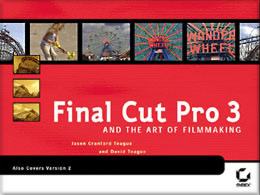
Published by Sybex
By Jason Cranford Teague and David Teague
ISBN 0-7821-4027-0
List price: $60.00 U.S.
Street Price $42.00
Companion DVD
396 pages
Review By Ken
Stone
Book excerpt follows review.
Final Cut Pro 3 and the Art of Filmmaking is a handsome book. It is printed in 'landscape' layout and features full color images throughout. Having Timeline shots, dialog boxes, overlays, Viewer and Canvas windows in color helps visualize what is being demonstrated in the accompanying lessons. Showing the Color Corrector 3-way filter in color is also very helpful.
The book is well organized and
the edges of each page are color coded for each of the five main
sections.
- Getting Started
- Editing Your Movie
- Adding Special Effects
- Advanced Techniques
- After Editing Is Done
This book is written for the FCP
beginner. The introduction includes information on some of the
hardware involved and the basic set up of FCP. The book then
moves through all the basics elements. There is a complete tour
of the FCP interface and all of its attending dialog boxes; each
is clearly noted and explained. One thing I noticed is that while
the authors demonstrate a good understanding of NLE, some of
the terms used in the book are more NLE oriented as opposed to
FCP specific.
Each lesson in the book is written
in a step by step fashion, each step illustrated. All of the
basic elements of FCP are touched on. Written for the beginner
these lessons do not go into great depth about each topic but
rather offer simple explanations.
- Setting Up Your Workstation
- Getting To Know Final Cut Pro
- Creating Your Footage
- Logging Your Footage
- Capturing Your Footage
- Working With Your footage
- Making Smart Edits
- Adding Transitions
- Adding Titles
- Using Image Control
- Manipulating the Image
- Compositing and Alpha Channels
- Using Motion Controls
- Creating Special Effects with
Key Filters
- Fine-Tuning Your Audio
- Making Keyframes Work for You
- Putting It All Together
- Managing Your Media
- Printing to Video
- Compressing Video for the Web,
CDs and DVDs
The Book comes with a companion
DVD. The DVD supports the lessons of the book, providing you
with footage used in the exercises found in the book. There are
also several different Project files, for different lessons,
included along with the footage that belongs to the Project.
This can be very helpful if you do not yet have your own footage.
There is also a short video documentary 'Coney Island Memories'
with the supporting clips for you to work with.
Starting with chapter 12, the book
is interspersed with a number of interviews with video editors
and artists, what the authors call 'Real World' profiles.
I feel that I need to point out
that the book that is now shipping (the book that I am reviewing
here) is a reprint. I did find a number of errors in the first
version of this book and waited until this new version was released
before I reviewed the book. Most of the errors were corrected.
On page 139 there are two shots of the TL depicting FCP editing
tools. The tools shown in the photos are incorrect, the 'Roll'
tool is shown when the book is talking about the 'Ripple' tool.
All in all, this is a good beginner's
book. Its strength comes from the excellent layout along with
the full color printing. It really is helpful to have color photos
of the TL and other FCP boxes as you can see the different colored
elements that act as strong visual guides when actually working
in FCP. The pictures in the book look like FCP on the screen.
Enjoy,
--ken
Book Excerpt from Final
Cut Pro 3 and the Art of Filmmaking
Part II - Editing Your Movie - Making Smart Edits
By Jason Cranford Teague and David Teague
HTML re-creation
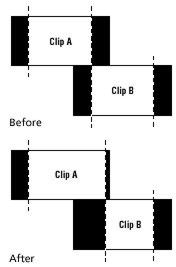
Making Roll Edits
A Roll edit keeps every clip at
exactly the same position in the Timeline, but it adds or subtracts
frames from the beginning of the incoming clip to accommodate
the trimming of the outgoing clip. In the example shown here,
if you add a few frames to the end of clip A, the first few frames
of clip B on the same track in the Timeline will be subtracted
to make room. Likewise, if you decided to take ten frames off
the end of clip A, clip B would start ten frames earlier. In
other words, you are moving the cut itself backward or forward.
Compare this to the diagrams of other edit types you'll see later
in this chapter. The Roll edit is especially helpful in music
videos or other projects where you have to keep precise synch
with the audio.
| 1. After
adding the clips that you want to edit to your Timeline (see
Chapter 6) choose the Roll Edit tool (R) from the Tool Palette.
This changes your cursor to the Roll tool and allows you to select
an edit point to roll. |
|
 |
2. With the Roll Edit cursor, select the edit
you want to trim by double-clicking between the two clips (which
we will refer to as A and B). This will bring up the Trim Edit
window with Clip A (outgoing clip) on the left and Clip B (incoming
clip) on the right.
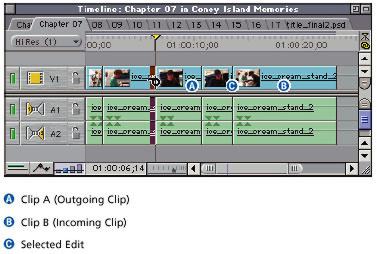
3. In the Trim Edit window, to "roll"
the edit back and forth, click the Trim Back or Trim Forward
buttons to add or subtract in increments of 1 or 5 frames at
a time. For every frame increment that you add, clip A will increase
and clip B will be cut by the same number of frames. As with
other types of editing, however, this depends on how many frames
clips A and B have available as trim. If you try to roll an edit
past the beginning or end of the clip's original media file,
Final Cut Pro will inform you that there is not enough media
to perform this edit.
In the Trim Edit window, you can
also specify an exact number of frames to add or subtract, by
typing either the plus or minus key and then the number of frames
followed by the Return key. For example, entering +27 adds 27
frames to the selected clip at the point of the selected cut.

4. Now preview your revised edit in the Trim
Edit window by clicking the Play Around Edit Loop button (or
pressing the spacebar). You can continue to adjust your edit
as desired by repeating steps 3 and 4.

5. Once you've finished fine-tuning your edit,
close the Trim Edit window either by clicking the Close button
in the top-left corner of the window or by simply clicking in
the Timeline. The clips in the Timeline will reflect the changes
you've just made.

Alternate Steps:
Roll Edits in the Timeline
The Trim Edit window gives you
microscopic control over your roll edits. However, you can also
control roll edits directly and more quickly (although more roughly)
in the Timeline. Starting after step 1 of the Making Roll Edits
procedure, do the following:
2. Select the edit between two clips you want
to roll with the Roll cursor. This edit will become highlighted.
If you need to zoom in for more precise frame-by-frame editing,
use the Magnifying Glass as described earlier.
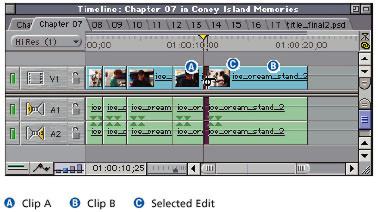
3. Click and drag the clip add or subtract
frames from the two clips. This will change the In or Out Points
of both clips. You can also click on the cut, type + or
followed by the number of frames you want to ripple, and then
press Return. Remember, though, that the clip needs to have trimmed
frames available at the edit point in order to be added using
the roll. Remember, you cannot add frames past the Media Limit,
which is the first or last frame you captured from the source
tape.
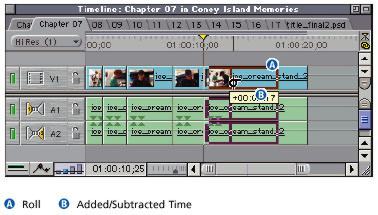
Text excerpted and abridged from Final
Cut Pro and the Art of Filmmaking by permission of SYBEX Inc.
Copyright 2002, SYBEX Inc. All rights reserved.
You can purchase 'Final Cut Pro 3 and
the Art of Filmmaking' from the lafcpug
store.
Review copyright ©
www.kenstone.net 2002
This article first appeared on www.kenstone.net and is reprinted here
with permission.
All screen captures and
textual references are the property and trademark of their creators/owners/publishers.